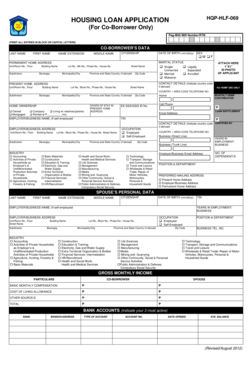Fill and Sign the Pag Ibig Housing Loan Application Form for Co Borrower

Valuable instructions on setting up your ‘Pag Ibig Housing Loan Application Form For Co Borrower’ online
Are you fatigued by the inconvenience of handling paperwork? Seek no more than airSlate SignNow, the premier eSignature solution for individuals and businesses. Bid farewell to the monotonous task of printing and scanning documents. With airSlate SignNow, you can effortlessly finalize and authorize paperwork online. Utilize the robust features integrated into this user-friendly and economical platform and transform your method of document management. Whether you need to validate forms or collect eSignatures, airSlate SignNow manages it all effortlessly, with just a few clicks.
Follow this detailed guide:
- Log in to your account or initiate a free trial with our service.
- Click +Create to upload a file from your device, cloud storage, or our form repository.
- Open your ‘Pag Ibig Housing Loan Application Form For Co Borrower’ in the editor.
- Click Me (Fill Out Now) to finish the document on your part.
- Insert and allocate fillable fields for others (if needed).
- Continue with the Send Invite settings to solicit eSignatures from others.
- Save, print your version, or convert it into a reusable template.
No need to worry if you require to work with your colleagues on your Pag Ibig Housing Loan Application Form For Co Borrower or send it for notarization—our platform offers everything you need to accomplish such tasks. Register with airSlate SignNow today and elevate your document management to a new level!
FAQs
-
What is the Pag Ibig Housing Loan Application Form For Co Borrower?
The Pag Ibig Housing Loan Application Form For Co Borrower is a crucial document required for individuals applying for a housing loan under the Pag Ibig Fund. This form allows multiple borrowers to apply together and share the loan responsibilities. Completing this form accurately is essential for a smooth loan application process.
-
How do I complete the Pag Ibig Housing Loan Application Form For Co Borrower?
To complete the Pag Ibig Housing Loan Application Form For Co Borrower, gather all necessary documents, such as identification and proof of income. Ensure that all fields are filled out accurately to avoid delays in processing. You can use airSlate SignNow to eSign and manage your application easily.
-
What are the benefits of using airSlate SignNow for the Pag Ibig Housing Loan Application Form For Co Borrower?
Using airSlate SignNow for your Pag Ibig Housing Loan Application Form For Co Borrower streamlines the signing process, making it faster and more efficient. You can securely eSign documents from any device, track progress, and ensure compliance with legal standards. This convenience saves you time and reduces the risk of errors.
-
Is there a cost associated with using airSlate SignNow for the Pag Ibig Housing Loan Application Form For Co Borrower?
Yes, there is a cost associated with using airSlate SignNow, but it is designed to be a cost-effective solution for managing documents like the Pag Ibig Housing Loan Application Form For Co Borrower. The pricing plans are flexible, catering to different business needs, allowing you to choose the option that best suits your situation.
-
Can I integrate airSlate SignNow with other tools for my Pag Ibig Housing Loan Application Form For Co Borrower?
Absolutely! airSlate SignNow offers integrations with various applications and tools, enhancing your workflow when handling the Pag Ibig Housing Loan Application Form For Co Borrower. Whether you use CRM systems or cloud storage solutions, you can seamlessly connect them for improved efficiency.
-
What features does airSlate SignNow offer for the Pag Ibig Housing Loan Application Form For Co Borrower?
airSlate SignNow provides several features for managing the Pag Ibig Housing Loan Application Form For Co Borrower, including customizable templates, real-time collaboration, and secure eSigning. Additionally, you can automate reminders and track document status, ensuring that your application process remains organized and timely.
-
How secure is the airSlate SignNow platform for my Pag Ibig Housing Loan Application Form For Co Borrower?
Security is a top priority for airSlate SignNow, especially when dealing with sensitive documents like the Pag Ibig Housing Loan Application Form For Co Borrower. The platform utilizes advanced encryption and complies with industry standards to protect your data, ensuring that your information remains confidential and secure.
Related searches to pag ibig housing loan application form for co borrower
Find out other pag ibig housing loan application form for co borrower
- Close deals faster
- Improve productivity
- Delight customers
- Increase revenue
- Save time & money
- Reduce payment cycles

